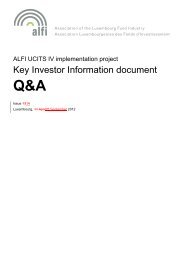law of 20 December 2002 - Alfi
law of 20 December 2002 - Alfi
law of 20 December 2002 - Alfi
- No tags were found...
You also want an ePaper? Increase the reach of your titles
YUMPU automatically turns print PDFs into web optimized ePapers that Google loves.
If the UCITS is established as a UCITS with multiple compartments, such informationmust be provided for each compartment.c) the other possible expenses and feesThe UCITS must indicate the management fee and, as the case may be, theperformance fee as well as other possible expenses and fees, distinguishing betweenthose to be paid by the investor and those to be paid out <strong>of</strong> the assets <strong>of</strong> the UCITS.Furthermore, the UCITS may calculate a total expense ratio. The total expense ratio,hereafter Total Expense Ratio (TER), is the ratio <strong>of</strong> the gross amount <strong>of</strong> the expenses<strong>of</strong> the UCITS to its average net assets.If a UCITS calculates a TER, the rules set forth hereafter must be complied with.The average net assets must be calculated on the basis <strong>of</strong> the net assets <strong>of</strong> the UCITSeach time the NAV is calculated.The TER must be calculated at least once a year on an ex-post basis, in principle byreference to the fiscal year <strong>of</strong> the UCITS.The TER includes all the expenses levied on the assets <strong>of</strong> the UCITS such as themanagement expenses, performance fees, administration expenses, custodianexpenses, distribution expenses, remuneration <strong>of</strong> the auditor, remuneration <strong>of</strong> thelegal advisers, registration charges and duties. The TER does not include subscriptionand redemption fees directly paid by the investor.If a UCITS invests more than <strong>20</strong>% <strong>of</strong> its assets in other investment funds whichpublish a TER in accordance with this circular, a synthetic TER corresponding to suchinvestment must be indicated.Conversely, if the target funds do not publish a TER in accordance with this circular,the impossibility to calculate a synthetic TER for such portion <strong>of</strong> investments must bementioned.The simplified prospectus must indicate if the transaction costs are or are not includedin the TER.If the UCITS is established as a UCITS with multiple compartments or issues multipleclasses <strong>of</strong> shares/units, the TER is calculated per compartment and, as the case maybe, per class <strong>of</strong> shares/units.The simplified prospectus may indicate the turnover rate <strong>of</strong> the portfolio on an annualbasis, hereafter portfolio turnover rate. The portfolio turnover rate <strong>of</strong> a UCITS or, asthe case may be, <strong>of</strong> a compartment must be calculated as follows:Turnover = [(Total 1 – Total 2)/M]*100with:Total 1 = Total <strong>of</strong> securities transactions during the relevant period = X + Ywhere X = purchases <strong>of</strong> securities and Y = sales <strong>of</strong> securitiesTotal 2 = total <strong>of</strong> transactions in units/shares <strong>of</strong> the UCITS during the relevant period = S + Twhere S = subscriptions <strong>of</strong> units/shares <strong>of</strong> the UCITS and T = redemptions <strong>of</strong> units/shares <strong>of</strong> theUCITSM = average monthly assets <strong>of</strong> the UCITSThe information relating to the TER, the portfolio turnover rate and the historicalperformances can be reflected in the simplified prospectus or on a sheet annexed tothe simplified prospectus.<strong>20</strong>3
















